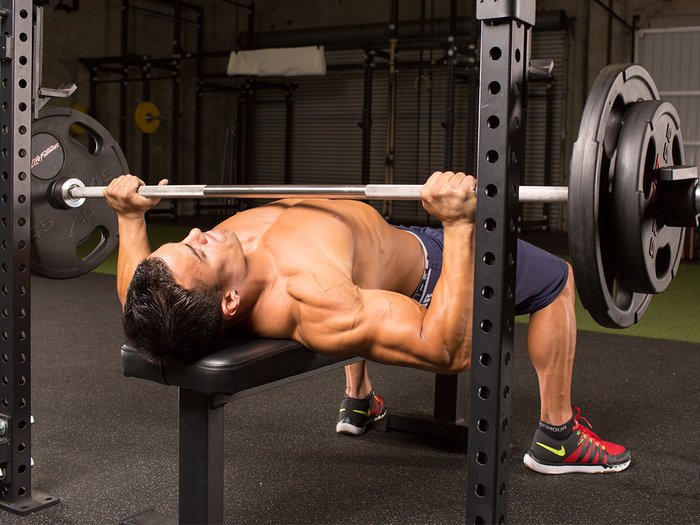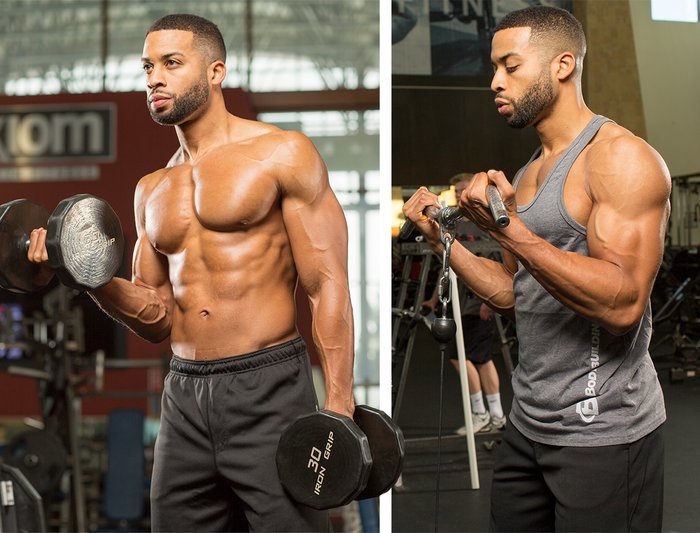You could spend the rest of your lifting days doing just the basics over and over again, but don't expect your physique or your strength to make much progress. Training at the intermediate level requires making a conscious decision to increase your efforts in the gym. It also means changing the way you approach training frequency and expanding on your staple exercises.
Here are three of the most important lessons you'll need to learn—and practice—as an intermediate lifter looking to make further gains.
Lesson 1: Add Volume, Cut Frequency
Many starter programs are centered around learning basic movement patterns and repeating them over and over again until they become second nature. But then your body adapts to them—initially through motor learning as you become more coordinated, and later through actual gains in muscle size and strength. If you want to progress, you need to increase the amount of targeted work you do on each muscle group.
As a beginner, you might have done 1-2 chest exercises. As an intermediate, you need to up the ante, and one way is by adding another 1-2 movements that work your pecs from different angles. If your routine already includes bench presses to target your middle pecs, add incline presses to better hit your uppers. The added volume allows you to work the chest musculature more fully, giving you better overall development.

Adding sets with more exercises increases your volume (a factor that's directly linked to muscle growth), but it also lengthens your workout. If you double the number of exercises you do, you've nearly doubled your time in the gym. And the extra work leads to greater next-day muscle soreness, meaning it will take you longer to recover.
The solution? As you increase volume, decrease your frequency. Instead of doing a full-body workout three times a week, try splitting it into upper body and lower body, or into separate muscle groups. Workouts can even be split into muscles that "push" (shoulders, chest, and triceps), muscles that "pull" (back and biceps), and legs.
This lets you hit each body part twice a week or every four days, which allows you to do more work on each muscle group—without extending your daily gym time—though it will likely require more trips to the gym each week.

Lesson 2: Learn Variations of Your Favorite Exercises
Beginners practice basic movement patterns that build muscle and strength. But as you advance, you expand that universe by learning how to use a greater variety of equipment, which gives you an opportunity to build more muscle.
For instance, you may have learned how to do biceps curls standing with an EZ-bar, but you can also do curls with a barbell. And by slightly changing how (overhand, underhand) and where (inside or outside your shoulders) you grip the bar, you can slightly alter the muscle-recruitment pattern, which can lead to more muscle growth.
Like many other exercises, curls can also be done with dumbbells, which affords greater freedom around the shoulder joint. Doing them with a cable allows you to vary the angle of pull on the muscle, depending on where the pulley is set. You can also do them either seated or standing, or do them one arm at a time instead of both.
Some types of curls can also be done on machines. Here the movement pathway is controlled. Since brands of machines offer their own advantages, using more than one machine can also offer variety.
Each type of equipment has unique advantages and disadvantages, so you'll want to eventually find ways to include all the equipment you have access to in your training. Learning how to do an exercise multiple ways allows for better overall muscular development. It can also be helpful on those days when the gym is crowded and a bunch of people are using the equipment you need. Rather than wait, simply try an alternate move and your workout is back on track.
Lesson 3: Keep Challenging Yourself
You know all those sensational gains you quickly made as a beginner? As you may have noticed, gains in size and strength become increasingly difficult to achieve the longer you train. That's all according to plan—nature's plan, that is. As you challenge your body in the gym, muscles become bigger and stronger to meet that challenge. Growth of fast-twitch muscle fibers make doing that same task easier in the future.

But if you want to continue to increase muscle mass and strength, you have to keep raising the bar through the principle of progressive overload. The idea behind progressive overload is to never get too comfortable with your training.
If you've stopped seeing gains, it may be time to change up your workout. Start by switching up the exercises you do or the order you do them in. You can also manipulate volume, load, rest periods, intensity techniques, or even the arrangement of your training split.
As a rule, changing up your workout every six weeks or so can help you keep building muscle, strength, and endurance. It also helps keep your workout and your attitude fresh.




